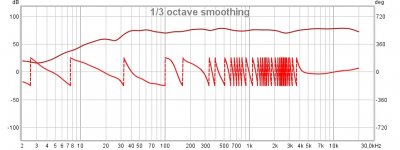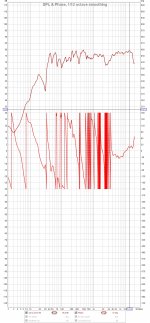Vetusto sorry bro , I think I commented on the wrong thread, anyway having 4 is good to make regular tweeter, put em series with a good cap and coil., or third order with two caps... doubles the power handling and volume output..very good teeeter
Now I began to understand. 🙂)
Thanks buddy!
When I have a finished crossover circuit I will post it here so you can tell if I'm digging in the right direction or not.
Thanks buddy!
When I have a finished crossover circuit I will post it here so you can tell if I'm digging in the right direction or not.
Good day, friends! Today ebey came across a crossover from Tannoy. The thought came, but not whether to buy it? Please see the link:
Pair TANNOY Super Tweeter ST-50 ST-100 ST-200, ST 50 100 200 speaker crossovers | eBay
Pair TANNOY Super Tweeter ST-50 ST-100 ST-200, ST 50 100 200 speaker crossovers | eBay
Good day and good mood, Colleagues! I found a specialist to help me make crossovers. But he asks for an impedance graph. I couldn't find it on the internet. I would be very grateful if you can find this impedance graph for Foster E100T10 tweeters.
I know this, but this specialist says that there must also be an impedance graph. as he explained, it is a curve showing AC resistance versus frequency. or is that nonsense? where does the alternating current come from? ...
No, it’s normal to show the impedance vs frequency. For normal dome tweeters the impedance is not linear, which means it’s affects the cross over frequency, but ribbon tweeters have flat impedance and easier to work with. A graph is not really needed.
Colleagues, forgive me for torturing you, but I still need your help. 🙂
?????? ???????? ???????????? ??????
Found a calculator for calculating filters of different orders. Calculator in Russian. You can translate the page using google translate.
And now I've been sitting for two hours studying this calculator, and studying the technical characteristics of the tweeters I have, and I can't figure out where I can get these values from:
The impedance of the speaker at this frequency r (hi). Where can I find this value?
Or maybe due to the fact that I have a ribbon tweeter, I have this value constant and equal to 8 Ohms?
If you enter a value:
cutoff frequency - 10000 Hz
And put the resistance to 8 ohms
Then I get that I need a 1 microfarad (mF) capacitor
A 0.255 milliHenry (mH) inductor.
Right?
These are the details I picked up:
Condenser MKP Mundorf MCap Supreme 600 VDC 1.00 uF
Inductor Jantzen Cross Coil 16 AWG / 1.3 mm 0.25 mH 0.16 Ohm
?????? ???????? ???????????? ??????
Found a calculator for calculating filters of different orders. Calculator in Russian. You can translate the page using google translate.
And now I've been sitting for two hours studying this calculator, and studying the technical characteristics of the tweeters I have, and I can't figure out where I can get these values from:
The impedance of the speaker at this frequency r (hi). Where can I find this value?
Or maybe due to the fact that I have a ribbon tweeter, I have this value constant and equal to 8 Ohms?
If you enter a value:
cutoff frequency - 10000 Hz
And put the resistance to 8 ohms
Then I get that I need a 1 microfarad (mF) capacitor
A 0.255 milliHenry (mH) inductor.
Right?
These are the details I picked up:
Condenser MKP Mundorf MCap Supreme 600 VDC 1.00 uF
Inductor Jantzen Cross Coil 16 AWG / 1.3 mm 0.25 mH 0.16 Ohm
Last edited:
The values are correct. You should still meassure. A phone with a frequency analyser app is better than nothing.
O! Don't worry about that. 🙂 I drove to the store yesterday and bought a measuring microphone, sound card and cable. I be will measure the frequency response of my main system.
True, when I was leaving the store, my beloved Mercedes began to twitch and fell into emergency mode. Something must have happened to the gearbox. Drove him today in a tow truck to the service center. Therefore, yesterday I was very upset and did not take measurements. But today, if the service center does not upset me too much, then I will definitely measure everything. 🙂
True, when I was leaving the store, my beloved Mercedes began to twitch and fell into emergency mode. Something must have happened to the gearbox. Drove him today in a tow truck to the service center. Therefore, yesterday I was very upset and did not take measurements. But today, if the service center does not upset me too much, then I will definitely measure everything. 🙂
In general, I made trial measurements of my speaker system. This is all too much ... In jerks? And there are too many ups and downs. Please look at the charts.
What I understood from these graphs is that my system clearly works out both 20 Hz and 20 kHz. Attenuation is observed at 14-15 kHz, and even then it is not significant. From these graphs it is possible to tell at what frequency my supertwitters should be cut?
What I understood from these graphs is that my system clearly works out both 20 Hz and 20 kHz. Attenuation is observed at 14-15 kHz, and even then it is not significant. From these graphs it is possible to tell at what frequency my supertwitters should be cut?
Attachments
Yes, I understand that. The joke is very cool.Welcome to the real world.
But my speaker system will be difficult to take out into the open air. 90 kilograms each speaker. 🙂
And yet, forgive me for torturing you, but I have to ask for your help to help me figure out the schedule and achieve an understanding at what frequency to cut Twitter.
The attenuation on the graph starts at 14 kHz. Does this mean that the crossover must be done from 14 kHz?
P.S. I will do many different sizes at different frequencies today.
First, I dont think your tweeter cuts at 14 kHz, it’s either your software that has a upper limit (often adjustable) or the mic that roll off, but still unusual with such steep roll off.
Second, you need to measure the off axis roll off. My suggestion is to add the super tweeter above the off axis roll off. You should measure 30, 40 and 60 degree off axis.
Third, placement of tweeter. You should experiment with backfiring or upfiring the super tweeter or something in between.
Second, you need to measure the off axis roll off. My suggestion is to add the super tweeter above the off axis roll off. You should measure 30, 40 and 60 degree off axis.
Third, placement of tweeter. You should experiment with backfiring or upfiring the super tweeter or something in between.
First, I dont think your tweeter cuts at 14 kHz, it’s either your software that has a upper limit (often adjustable) or the mic that roll off, but still unusual with such steep roll off.
My English is poor. 🙂 Apparently, I asked the question incorrectly.
I will try to repeat: judging by the graphs, my main system has a drop in frequency values around 14 kHz, but this drop is insignificant. If I want to get the WOW effect from my system along with the supertwitters I'm currently designing, then I need to make the supertwitters work at a frequency from 14 kHz to their maximum of 40 kHz. Did I understand correctly?
This message is also not entirely clear. Are you saying that I need to connect the supertwitter to the main system? And then again take measurements at different angles? Did I understand correctly? But if I understand correctly, then how can I connect a supertwitter to the system if I don't have a crossover project yet? 🙂Second, you need to measure the off axis roll off. My suggestion is to add the super tweeter above the off axis roll off. You should measure 30, 40 and 60 degree off axis.
Or just take different measurements at different angles? And you only need to measure the basic acoustics system? No supertwitter.
You should measure the existing system. The tweeter will begin to beam at 4-5 kHz. I would ad a supertweeter between 7-10 kHz, then it will both fill in the off axis loss and extend to 40 kHz.
Last edited:
From what I’m gathering it’s a subjective trial and error process as there really is no formula for adding a super tweeter.
Main questions would be do you need to roll off the regular tweeter with an inductor and how much to pad the super tweeter.
Your roll off of tweeter (if correct) is quite sharp so I’d just put a series 1uf cap on the super tweeter and see what it sounds like……if it needs attenuation pick up adjustable L pads to find where you like it then you have the choice to measure the resistance and replace with fixed resistors or keep the adjustable.
Main questions would be do you need to roll off the regular tweeter with an inductor and how much to pad the super tweeter.
Your roll off of tweeter (if correct) is quite sharp so I’d just put a series 1uf cap on the super tweeter and see what it sounds like……if it needs attenuation pick up adjustable L pads to find where you like it then you have the choice to measure the resistance and replace with fixed resistors or keep the adjustable.
I understood everything, friends! today or tomorrow I'll take all measurements at different frequencies, I'll post it here. then we will discuss.
In general, I made trial measurements of my speaker system. This is all too much ... In jerks? And there are too many ups and downs. Please look at the charts.
What I understood from these graphs is that my system clearly works out both 20 Hz and 20 kHz. Attenuation is observed at 14-15 kHz, and even then it is not significant. From these graphs it is possible to tell at what frequency my supertwitters should be cut?
Most graphs you see has a scale on the y-axis that span 50 dB - yours are 200 dB and anything will look "nice and flat". Use that to get an idea how you compare to others you see.
//
- Home
- Loudspeakers
- Multi-Way
- how does one make a super tweeter


